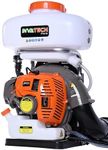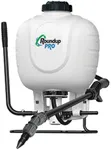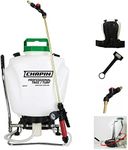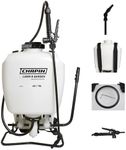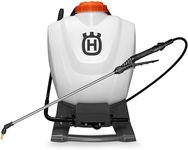Buying Guide for the Best Backpack Sprayers
Choosing the right backpack sprayer can make tasks like gardening, pest control, or cleaning much easier and more efficient. The best sprayer for you depends on what you plan to use it for, how often you'll use it, and your comfort with carrying and operating the equipment. Understanding the key features will help you select a sprayer that matches your needs and ensures you get the job done safely and effectively.Tank CapacityTank capacity refers to how much liquid the sprayer can hold at one time. This is important because a larger tank means you can cover more area without stopping to refill, but it also makes the sprayer heavier and harder to carry. Small tanks (around 2-3 gallons) are lighter and easier to handle, making them suitable for small gardens or spot treatments. Medium tanks (4 gallons) offer a balance between capacity and weight, ideal for most home users. Large tanks (5 gallons or more) are best for big properties or commercial use, but they can be heavy when full. Choose a tank size that matches the size of your project and your ability to carry the weight comfortably.
Pump TypeBackpack sprayers use either manual pumps (piston or diaphragm) or battery-powered pumps to build pressure. Manual pumps require you to pump a handle to pressurize the tank, which is simple and reliable but can be tiring for large jobs. Battery-powered pumps do the work for you, making spraying easier and more consistent, especially for longer tasks. Piston pumps are good for general use with most chemicals, while diaphragm pumps handle abrasive or thicker solutions better. If you have a lot of spraying to do or want less physical effort, a battery-powered or diaphragm pump may be best. For occasional or light use, a manual piston pump is usually sufficient.
Spray Wand and Nozzle OptionsThe spray wand and nozzle control how the liquid is applied. Adjustable wands and multiple nozzle types let you change the spray pattern from a fine mist to a direct stream, which is important for different tasks like covering large areas or targeting specific plants. Some sprayers come with interchangeable nozzles for more flexibility. If you need to do a variety of jobs, look for a sprayer with adjustable or multiple nozzles. For single-purpose use, a fixed nozzle may be enough.
Comfort and StrapsSince you'll be carrying the sprayer on your back, comfort is key. Look for padded shoulder straps and a waist belt, which help distribute the weight and reduce strain. Some models also have ergonomic back pads for extra support. If you plan to use the sprayer for long periods or have a larger tank, good padding and support are especially important. For short or occasional use, basic straps may be sufficient.
Pressure ControlPressure control determines how forcefully the liquid is sprayed. Some sprayers have adjustable pressure settings, which let you choose a gentle spray for delicate plants or a stronger stream for tough weeds. Fixed-pressure sprayers are simpler but less versatile. If you need to spray different types of plants or surfaces, adjustable pressure is helpful. For single, straightforward tasks, fixed pressure may be all you need.
Ease of Cleaning and MaintenanceKeeping your sprayer clean is important for safety and performance. Some sprayers have wide openings for easy filling and cleaning, and removable parts that make maintenance simpler. If you plan to use different chemicals or want to keep your equipment in good shape, look for a sprayer that's easy to take apart and clean. For occasional use with the same solution, this may be less critical.
